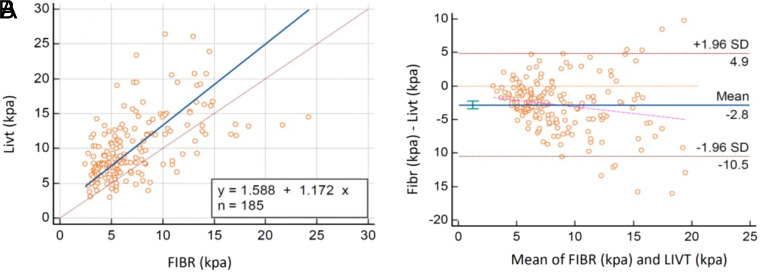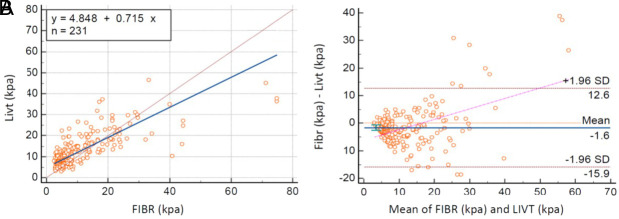下载PDF
{"title":"Liver Stiffness and Steatosis Measurements with iLivTouch and FibroScan: A Comparative Study.","authors":"Mübin Özercan, Zeynep Melekoğlu Ellik, Ayhan Parmaksız, Mesut Gümüşsoy, Serkan Duman, Necati Örmeci","doi":"10.5152/tjg.2024.23531","DOIUrl":null,"url":null,"abstract":"<p><p>The presence of liver fibrosis is the most important indicator of progression to cirrhosis. Noninvasive measurement of liver stiffness is crucial for detecting fibrosis. Vibration-controlled transient elastography is one of the most useful methods for this purpose. We aimed to compare the liver stiffness and steatosis measurements with iLivTouch© and the FibroScan© elastography devices Two hundred thirty-seven consecutive adult patients with chronic hepatitis were included in the study. The liver stiffness and steatosis were measured with iLivTouch and FibroScan on the same day. Thirty-one patients had liver biopsies on the same day with elastography procedures. The diagnostic performances of iLivTouch and FibroScan were compared to aspartate aminotransferase to platelet ratio index (APRI), Fibrosis-4 (FIB-4), and nonalcoholic fatty liver disease fibrosis score (NFS). The liver stiffness measurements obtained using iLivTouch and FibroScan had median value of 10.3 (ranging from 2.9 to 46.3) and 7.2 (ranging from 2.5 to 75), respectively. The mean steatosis measurements using ultrasound attenuation parameter with iLivTouch were 245.51 ± 45.79, while the mean controlled attenuation parameter measurements using FibroScan were 259.37 ± 75.0. In subgroup analysis, the AUC of iLivTouch on detecting signiicant fibrosis [0.83, (P = .002)] was minimally higher than other noninvasive methods [0.82 for NFS (P = .003), 0.80 for FibroScan (P = .006), 0.68 for FIB-4 (P = .089), and 0.53 for APRI (P = .76)]. The stiffness and steatosis measurements with iLivTouch and FibroScan were not similar. The accuracy of iLivTouch in detecting significant and advanced fibrosis was minimally higher. Large clinical trials are necessary to support these findings.</p>","PeriodicalId":51205,"journal":{"name":"Turkish Journal of Gastroenterology","volume":"35 8","pages":"634-642"},"PeriodicalIF":1.6000,"publicationDate":"2024-06-06","publicationTypes":"Journal Article","fieldsOfStudy":null,"isOpenAccess":false,"openAccessPdf":"https://www.ncbi.nlm.nih.gov/pmc/articles/PMC11363179/pdf/","citationCount":"0","resultStr":null,"platform":"Semanticscholar","paperid":null,"PeriodicalName":"Turkish Journal of Gastroenterology","FirstCategoryId":"3","ListUrlMain":"https://doi.org/10.5152/tjg.2024.23531","RegionNum":4,"RegionCategory":"医学","ArticlePicture":[],"TitleCN":null,"AbstractTextCN":null,"PMCID":null,"EPubDate":"","PubModel":"","JCR":"Q4","JCRName":"GASTROENTEROLOGY & HEPATOLOGY","Score":null,"Total":0}
引用次数: 0
引用
批量引用
Abstract
The presence of liver fibrosis is the most important indicator of progression to cirrhosis. Noninvasive measurement of liver stiffness is crucial for detecting fibrosis. Vibration-controlled transient elastography is one of the most useful methods for this purpose. We aimed to compare the liver stiffness and steatosis measurements with iLivTouch© and the FibroScan© elastography devices Two hundred thirty-seven consecutive adult patients with chronic hepatitis were included in the study. The liver stiffness and steatosis were measured with iLivTouch and FibroScan on the same day. Thirty-one patients had liver biopsies on the same day with elastography procedures. The diagnostic performances of iLivTouch and FibroScan were compared to aspartate aminotransferase to platelet ratio index (APRI), Fibrosis-4 (FIB-4), and nonalcoholic fatty liver disease fibrosis score (NFS). The liver stiffness measurements obtained using iLivTouch and FibroScan had median value of 10.3 (ranging from 2.9 to 46.3) and 7.2 (ranging from 2.5 to 75), respectively. The mean steatosis measurements using ultrasound attenuation parameter with iLivTouch were 245.51 ± 45.79, while the mean controlled attenuation parameter measurements using FibroScan were 259.37 ± 75.0. In subgroup analysis, the AUC of iLivTouch on detecting signiicant fibrosis [0.83, (P = .002)] was minimally higher than other noninvasive methods [0.82 for NFS (P = .003), 0.80 for FibroScan (P = .006), 0.68 for FIB-4 (P = .089), and 0.53 for APRI (P = .76)]. The stiffness and steatosis measurements with iLivTouch and FibroScan were not similar. The accuracy of iLivTouch in detecting significant and advanced fibrosis was minimally higher. Large clinical trials are necessary to support these findings.
使用 iLivTouch 和 FibroScan 测量肝脏硬度和脂肪变性:比较研究
肝纤维化的存在是肝硬化进展的最重要指标。肝脏硬度的无创测量对于检测肝纤维化至关重要。振动控制瞬态弹性成像是最有用的方法之一。我们的目的是比较 iLivTouch© 和 FibroScan© 弹性成像设备对肝脏硬度和脂肪变性的测量结果。在同一天使用 iLivTouch 和 FibroScan 测量肝脏硬度和脂肪变性。31名患者在进行弹性成像程序的同一天进行了肝活检。将 iLivTouch 和 FibroScan 的诊断性能与天冬氨酸氨基转移酶与血小板比值指数(APRI)、纤维化-4(FIB-4)和非酒精性脂肪肝纤维化评分(NFS)进行了比较。使用 iLivTouch 和 FibroScan 测量的肝脏硬度中值分别为 10.3(范围在 2.9 至 46.3 之间)和 7.2(范围在 2.5 至 75 之间)。使用 iLivTouch 的超声衰减参数平均脂肪变性测量值为 245.51 ± 45.79,而使用 FibroScan 的受控衰减参数平均测量值为 259.37 ± 75.0。在亚组分析中,iLivTouch 检测明显纤维化的 AUC [0.83, (P = .002)] 略高于其他无创方法 [NFS 为 0.82 (P = .003)、FibroScan 为 0.80 (P = .006)、FIB-4 为 0.68 (P = .089) 和 APRI 为 0.53 (P = .76)]。iLivTouch 和 FibroScan 的僵硬度和脂肪变性测量结果并不相似。iLivTouch 检测明显纤维化和晚期纤维化的准确性略高。有必要进行大型临床试验来支持这些研究结果。
本文章由计算机程序翻译,如有差异,请以英文原文为准。





